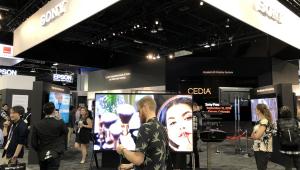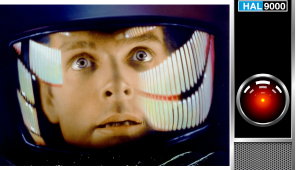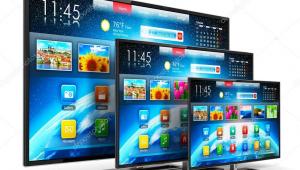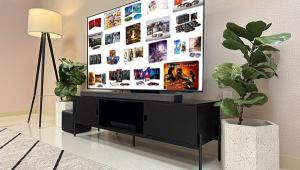LEDs, OLEDs, and Micro LEDs
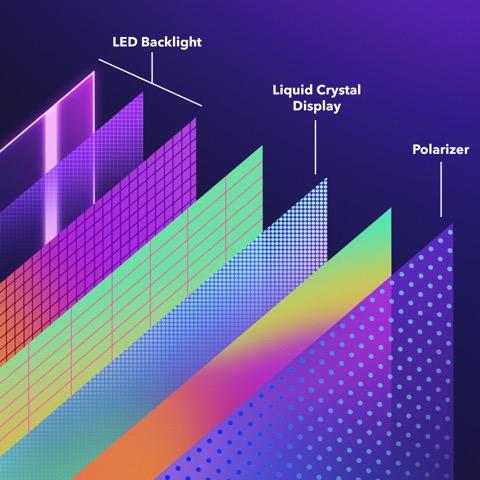
The oldest and most basic form of a flat screen television is the LCD, or Liquid Crystal Display. A layer of liquid crystals is sandwiched between two layers of polarizing filters. When an electric signal is applied to those filters (that signal being the source to be displayed) the liquid crystals align in changing patterns to produce the moving and (where needed) color image.
The full details on how this many-layered LCD panel performs these tasks are more complex than this brief description can convey without reams of diagrams. Eye-watering descriptions of the entire process are readily available on YouTube. But suffice it to say here that the actual moving and full color image is produced by this LCD panel.
But the LCD panel itself doesn't have the ability to illuminate, so some form of backlighting is needed to produce a viewable image. In the earliest LCD TVs that backlighting was produced by cold cathode fluorescent lamps (CCFLs) positioned behind the LCD imaging panel.
But those lowly LCD displays were soon improved by using LEDs (Light Emitting Diodes) for the needed backlighting. This improved on some aspects of the overall performance, but the stationary LED backlighting still didn't contribute anything to the party other than the somewhat important chore of making the moving images in the LCD panel visible!
Consumers flocked to those early LED TVs for their relative ease of installation compared to the dominant CRT TVs of the day. But there were issues remaining and competition soon drove TV makers to improve the performance of their LED TVs. Two developments, in particular, made their way into the LED TV market: local dimming and quantum dots.
The LED backlighting on an LED TV consists of a large number of LEDs uniformly spread out across the backlight panel. But in early LED TVs the illumination of this LED backlighting was fixed at maximum to offer bright, punchy images. Any reduction of that light level, as required by the source, was the job of the LCD imaging panel sitting in front of the unchanging backlight. But there's always at least some light leakage through the LCD panel. The result was compromised contrast and mediocre black levels seen by the viewer.
But suppose we divide those backlight LEDs into multiple zones and process each of these zones separately, as needed, to respond instantly to the changing brightness requirements of the source. Yes, the LCD still produces the detailed image, but by adding variable illumination from the now active LED backlighting zones we can significantly improve an LED TV's overall contrast and black level.
That, in effect, is local dimming. It's now widely used in LED TVs of any distinction. But not all local dimming implementations are equally effective. The more dimming zones the better, but this will affect the price of the set. Nevertheless, even a modest application of local dimming can dramatically improve the contrast and black levels on an LED TV.
Another key advancement in many of today's LED TVs is the use of quantum dots. A quantum dot is a microscopic particle that glows either red or green (depending on its size) when it's hit by blue light. In a conventional LED TV, backlit by white light, the white must first be filtered to extract the red, green, and blue colors needed to generate full-color images. But with a blue backlight, assisted by the red and green light produced by the quantum dots, separate color filtration is unneeded. This offers the added benefit of a deeper, wider, and more accurate range of color.
Effectively controlling all of these performance benefits to work together demands sophisticated micro processing. All of today's TVs employ such microprocessors, often with creative and fanciful names. These names might even include the tech catchphrase of the decade: AI! But don't get too excited; no HDTV we know of can yet ascertain the program you planned to watch and switch to it even before you can grab the remote control!
Manufacturers have also generated a blizzard of names for what are, essentially, LED TVs. But there's another type of TV design that's genuinely different. It's OLED, or Organic Light Emitting Diodes. The fundamental difference here from an LED TV is that OLEDs are self-illuminating. They don't require a backlight.
Since each OLED can shut down completely where needed, OLEDs typically offer black levels and contrast superior to those achievable by any other widely available type of display. That's not to say that the best locally dimmed LED TVs can't come remarkably close. With careful setup they can. I've been living daily with the 85-inch TCL LED TV I reviewed last year and have had few complaints (though the impact of sheer screen size can also overwhelm minor reservations!). But once you've viewed the most challenging, near-black images on a good OLED TV, in a dim or near-darkened room, the experience is hard to forget.
The image on an LED TV begins fading when viewed at off-center angles starting at roughly 25-30 degrees. Viewers seated beyond that are unlikely to miss the loss of contrast. Some LED TVs are better at this than others, but none in my experience will fully challenge an OLED's "choose any seat" flexibility.
With these advantages, why would anyone choose an LED TV? The answers involve cost, peak brightness, something called burn-in, and range of available offerings.
OLED TVs tend to be pricier than high-end LED designs in equivalent screen sizes. LED TVs generally offer higher peak brightness levels, which can be significant if you plan to do most of your viewing in a brightly lit room. And even if not, program sources produced in high dynamic range might also offer more pop on an LED TV than on an OLED. If you watch a lot of such HDR material you might be happier with an LED TV.
Leaving a bright, stationary image on an LED TV for hours will affect little more than your electric bill. But on an OLED it might well leave a ghostly trace of that image on the screen. This might fade out over time depending on how bright the image was and how long it was left on the screen. If it's temporary, this is called image retention. But if it's permanent, it's true burn-in.
To be fair, burn-in can be avoided with a little extra care. It's never an issue with fully moving images, and today's OLEDs claim to be a little less prone to it than were earlier OLED designs. But even so, the fixed scoreboards common to video games and sports can be potential burn-in risks. And if you live in a busy household with the TV on for hours every day, and other users who might be less careful than you, a good LED-TV might be your best choice.
It's also true that a wider selection of LED TVs is available at wider price points than OLED offerings. And not all manufacturers offer OLEDs. In the US, Sony, LG, Panasonic and Samsung do (at least as of this writing) but TCL and Hisense do not.
But don't get too excited just yet. Manufacturers working on this type of display can't yet make individual Micro LEDs small enough to function directly as pixels in popular TV sizes. As a result, such TVs are, so far, available only in jumbo sizes, at truly eye-watering prices, and likely only at very specialized dealers or direct from the factory. Samsung can sell you a 114-inch model for around $150,000 (that's not a typo!), though they were out of stock when I checked!
For now, if the friendly salesperson at your local Best Buy or Costco claims that the TV you're looking at is a micro LED, it almost certainly is not and that salesperson is likely just confused. If and when they can make the pixel-sized LEDs small enough for popular sizes and at prices comparable to today's TVs, that could upset the whole television landscape. But don't expect to see them anytime soon.







